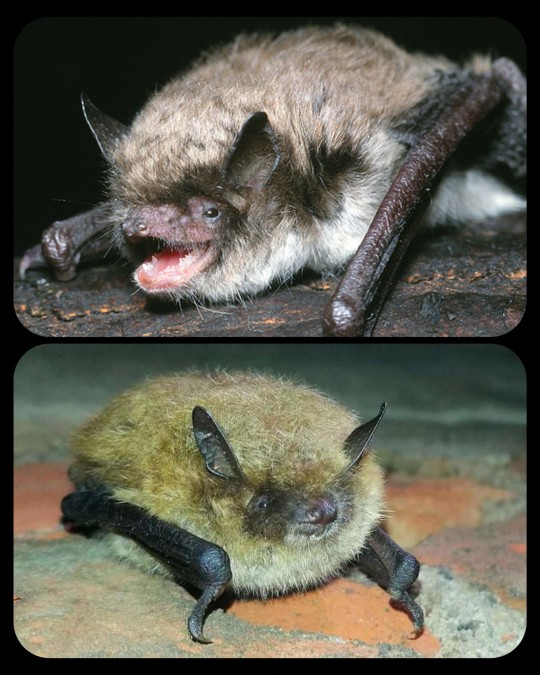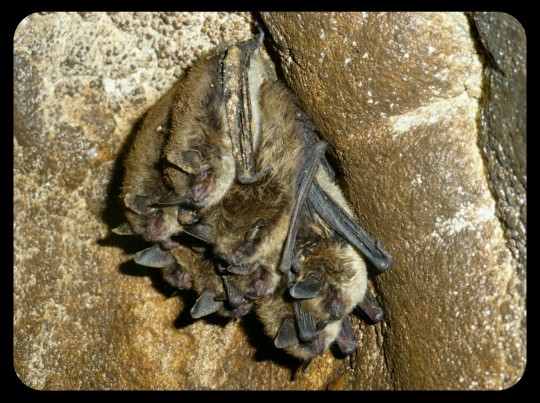#siberian whiskered myotis
Explore tagged Tumblr posts
Text
Brandt's Bat: researchers once documented a case in which a Brandt's bat had survived in the wild for more than 40 years, making this the longest-living bat species in the world

In 1964, a wild Brandt's bat (Myotis brandtii) was captured, banded, and released by researchers in the Biryusa region of Siberia. The very same bat was eventually recaptured by another team of researchers in 2005; it would have been at least 41 years old by then, making it the oldest bat ever recorded.
The previous record-holder was also a Siberian Brandt's bat (with an estimated age of 38 years).

There are twelve other species within the genus Myotis that have been documented living past the age of 20, but the lifespan of the Brandt's bat is exceptionally long, especially compared to other small mammals.
This species (and the longevity of a few other bat species) defies our conventional understanding of the relationship between an animal's size and its lifespan -- smaller animals normally have a much shorter lifespan compared to large animals, partly due to their higher metabolic demands, but these bats represent a rare exception to that rule. In fact, with an average weight of just 4 to 8 grams (which is roughly the combined weight of 2 or 3 pennies), the Brandt's bat has the longest lifespan of any mammal relative to its size.

Research suggests that its increased lifespan may be at least partially linked to a mutation in two of the genes that are related to growth. This article describes the results of one particular study:
Genes for two proteins involved in growth — called growth hormone receptor (GHR) and insulinlike growth factor 1 receptor (IGF1R) — showed changes that also appear among other long-lived bat species. Previous studies in mice and other animals suggest genetic changes in GHR and IGF1R are linked with longevity. For instance, mice with mutations in GHR live twice as long as normal mice, said study researcher Vadim Gladyshev, a geneticist at Brigham and Women's Hospital in Boston.
These same genetic changes also may be responsible for the bats' small size ...
"We think the bat's life span is, in part, an unintended consequence of its small body size."

There are a few other factors that may also play a role:
Brandt's bats also hibernate and roost in caves — behaviors that may help them avoid predators and extreme weather conditions, and contribute to their longer life span, the researchers said. The Brandt's bat also takes a relatively long time to reach maturity, and it does not produce many offspring — two characteristics seen in larger, longer-living mammals.

Note: nearly all of the articles that I came across refer to the 41-year-old bat as a "Brandt's bat," but at least one other source uses the term "Siberian whiskered myotis," instead. That term simply refers to the Siberian variety of the Brandt's bat (subspecies Myotis brandtii sibiricus) in particular.
Sources & More Info:
The Journals of Gerontology: A New Field Record for Bat Longevity
Bat Conservation International: Myotis brandtii
Nature: Genome Analysis Reveals Insights into Physiology and Longevity of the Brandt's Bat, Myotis brandtii
Nature: DNA Methylation Predicts Age and Provides Insight Into Exceptional Longevity of Bats
New Scientist: Gene Clues May Explain Why Brandt's Bat Lives So Long
#mammals#myotis brandtii#myotis brandtii sibiricus#siberian whiskered myotis#brandt's bat#siberia#bats#animals#longevity#world record#animal facts#nature#that bat is older than I am#and it looks like it has seen some shit#hang in there little buddy#(literally)
120 notes
·
View notes
Text
finnish mammals
majava - European beaver (Castor fiber)
orava - red squirrel (Sciurus vulgaris)
liito-orava - Siberian flying squirrel (Pteromys volans)
tammihiiri - garden dormouse (Eliomys quercinus)
koivuhiiri - northern birch mouse (Sicista betulina)
vesimyyrä - European water vole (Arvicola amphibius)
metsämyyrä - bank vole (Myodes glareolus)
harmaakuvemyyrä - grey red-backed vole (Myodes rufocanus)
punamyyrä - northern red-backed vole (Myodes rutilus)
tunturisopuli - Norway lemming (Lemmus lemmus)
peltomyyrä - field vole (Microtus agrestis)
kenttämyyrä - common vole (Microtus arvalis)
lapinmyyrä - tundra vole (Microtus oeconomus)
idänkenttämyyrä - southern vole (Microtus levis)
metsäsopuli - wood lemming (Myopus schisticolor)
peltohiiri - striped field mouse (Apodemus agrarius)
metsähiiri - yellow-necked mouse (Apodemus flavicollis)
vaivaishiiri - Eurasian harvest mouse (Micromys minutus)
rusakko - European hare (Lepus europaeus)
metsäjänis - mountain hare (Lepus timidus)
siili - European hedgehog (Erinaceus europaeus)
kotipäästäinen - lesser white-toothed shrew (Crocidura suaveolens)
vesipäästäinen - Eurasian water shrew (Neomys fodiens)
metsäpäästäinen - common shrew (Sorex araneus)
idänpäästäinen - Laxmann’s shrew (Sorex caecutiens)
mustapäästäinen - taiga shrew (Sorex isodon)
kääpiöpäästäinen - Eurasian least shrew (Sorex minutissimus)
vaivaispäästäinen - Eurasian pygmy shrew (Sorex minutus)
kontiainen - European mole (Talpa europaea)
vesisiippa - Daubenton’s bat (Myotis daubentonii)
viiksisiippa - whiskered bat (Myotis mystacinus)
ripsisiippa - Natterer’s bat (Myotis nattereri)
pohjanlepakko - northern bat (Eptesicus nilssonii)
korvayökkö - brown long-eared bat (Plecotus auritus)
kimolepakko - parti-colored bat (Vespertilio murinus)
doggilepakko - European free-tailed bat (Tadarida teniotis)
mustavalas - North Atlantic right whale (Eubalaena glacialis)
harmaavalas - grey whale (Eschrichtius robustus)
sillivalas - fin whale (Balaenoptera physalus)
lahtivalas - common minke whale (Balaenoptera acutorostrata)
rhyävalas - humpback whale (Megaptera novaeangliae)
pyöriäinen - harbour porpoise (Phocoena phocoena)
maitovalas - beluga whale (Delphinapterus leucas)
kaksihammasvalas - Sowerby’s beaked whale (Mesoplodon bidens)
valkokuonodelfiini - white-beaked dolphin (Lagenorhynchus albirostris)
rissondelfiini - Risso’s dolphin (Grampus griseus)
miekkavalas - orca (Orcinus orca)
ilves - Eurasian lynx (Lynx lynx)
naali - arctic fox (Vulpes lagopus)
kettu - red fox (Vulpes vulpes)
susi - grey wolf (Canis lupus)
karhu - brown bear (Ursus arctos)
ahma - wolverine (Gulo gulo)
saukko - Eurasian otter (Lutra lutra)
kärppä - stoat (Mustela erminea)
vesikko - European mink (Mustela lutreola)
lumikko - least weasel (Mustela nivalis)
hilleri - European polecat (Mustela putorius)
näätä - European pine marten (Martes martes)
soopeli - sable (Martes zibellina)
mäyrä - European badger (Meles meles)
supikoira - raccoon dog (Nyctereutes procyonoides)
mursu - walrus (Odobenus rosmarus)
halli - grey seal (Halichoerus grypus)
grönlanninhylje - harp seal (Pagophilus groenlandicus)
norppa - ringed seal (Pusa hispida)
villisika - wild boar (Sus scrofa)
hirvi - moose (Alces alces)
metsäkauris - roe deer (Capreolus capreolus)
peura - reindeer (Rangifer tarandus)
21 notes
·
View notes